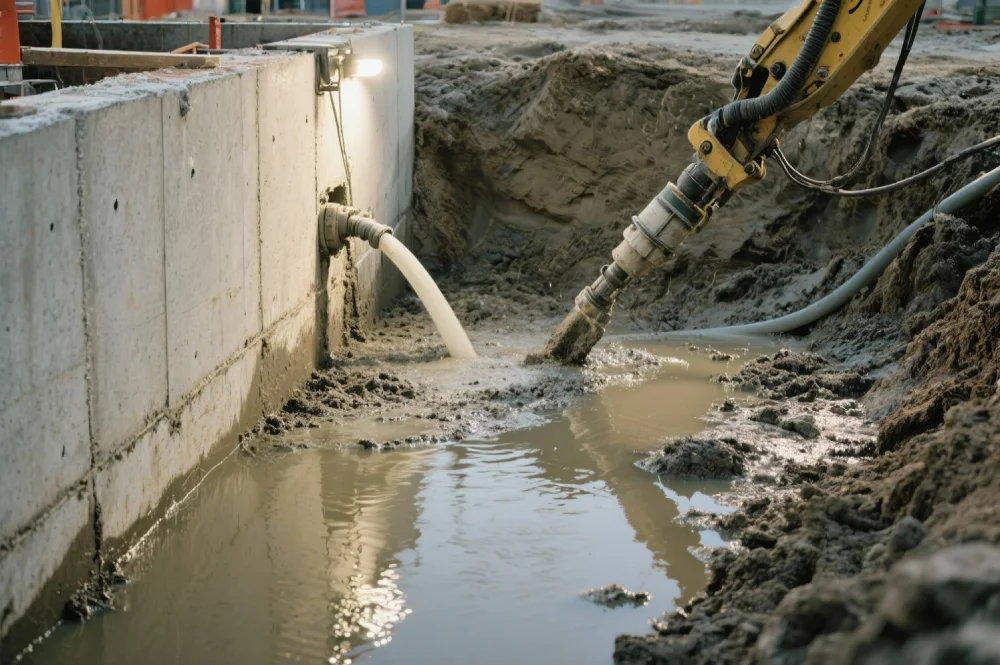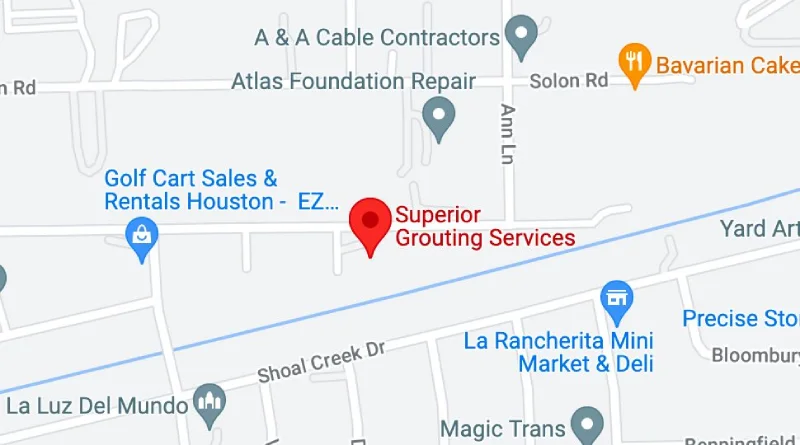Can Polyurethane Grouting Handle High-Water Table Problems?

Polyurethane grouting can effectively handle high-water table problems through its waterproof closed-cell structure that creates strong barriers against water infiltration, even under significant hydrostatic pressure. This makes it ideal for stabilizing soils and structures in high water table environments where groundwater saturation causes subsidence, erosion, or structural damage.
The foam is injected directly into saturated soil or voids where it expands, displaces water, fills gaps, and provides structural support. This process allows comprehensive stabilization under water-saturated conditions with minimal disruption to existing operations and infrastructure.
Professional polyurethane grouting services in Texas and nationwide utilize these water-resistant properties to address challenging groundwater conditions that conventional stabilization methods cannot handle effectively.
Key Takeaways
- Polyurethane grouting effectively handles high water table problems through closed-cell structure that creates waterproof barriers resistant to hydrostatic pressure.
- Foam injection displaces water while expanding to fill voids and stabilize soil, providing comprehensive treatment in water-saturated conditions.
- Closed-cell structure prevents water absorption and maintains structural integrity over time, unlike materials that deteriorate in wet conditions.
- Rapid curing allows immediate structural support even in water-saturated environments, enabling faster project completion in challenging conditions.
- Minimal installation disruption makes polyurethane ideal for occupied structures and active infrastructure affected by high water table problems.
- Long-term durability and adhesion properties ensure continued effectiveness despite ongoing exposure to groundwater and hydrostatic pressure variations.
Understanding High Water Table Challenges
High water table conditions present unique challenges for construction and infrastructure maintenance that require specialized solutions capable of performing in saturated soil environments.
Groundwater Impact on Infrastructure
High water tables create multiple problems for foundations, utilities, and underground structures through direct water contact and associated soil instability.
According to groundwater engineering research, high water table conditions are responsible for significant infrastructure damage through buoyancy forces, soil erosion, and foundation undermining.
Common High Water Table Problems:
- Hydrostatic pressure causing foundation uplift and structural movement
- Soil erosion and washout creating voids beneath structures
- Reduced soil bearing capacity due to saturation effects
- Buoyancy forces on underground utilities and storage tanks
- Seasonal fluctuations causing repeated stress cycles
Texas-Specific Water Table Issues
Texas infrastructure faces particular challenges from varying water table conditions, ranging from drought-induced deep water tables to flood-related high water table problems that can occur within short time periods.
| Region | Water Table Challenges | Infrastructure Impact |
| Gulf Coast | High water table, storm surge | Foundation issues, utility damage |
| East Texas | Seasonal variations | Settlement, structural movement |
| Central Texas | Flash flood effects | Rapid water table changes |
| South Texas | Irrigation impacts | Agricultural infrastructure issues |
Seasonal and Climate Variations
Climate patterns significantly influence water table levels and create dynamic conditions that require adaptable stabilization solutions.
Seasonal Impact Factors:
- Spring flooding raising water tables rapidly
- Summer drought conditions lowering groundwater levels
- Hurricane and tropical storm effects on coastal areas
- Irrigation and agricultural water usage patterns
- Urban development affecting natural drainage patterns
Polyurethane's Water Resistance Mechanisms
Polyurethane's effectiveness in high water table conditions stems from its unique cellular structure and chemical composition that provide excellent water resistance properties.
Closed-Cell Structure Benefits
The closed-cell structure of polyurethane foam creates individual sealed cells that prevent water infiltration and maintain structural integrity under hydrostatic pressure.
Structural Advantages:
- Individual cells prevent water absorption and migration
- Maintains buoyancy and structural properties when submerged
- Resists compression under hydrostatic pressure
- Provides thermal insulation reducing temperature effects
- Chemical resistance prevents deterioration from groundwater contaminants
Hydrostatic Pressure Resistance
Polyurethane foam can withstand significant hydrostatic pressure without structural failure or water infiltration, making it suitable for deep foundation applications.
According to materials engineering studies, closed-cell polyurethane foams maintain structural integrity under hydrostatic pressures equivalent to several feet of water head.
| Pressure Condition | Polyurethane Performance | Comparative Materials |
| Low Pressure (0-5 psi) | Excellent resistance | Most materials adequate |
| Moderate Pressure (5-15 psi) | Good resistance | Some materials fail |
| High Pressure (15+ psi) | Maintains integrity | Many materials compromise |
| Cyclic Loading | Stable performance | Progressive failure common |
Chemical Compatibility in Groundwater
Groundwater often contains dissolved minerals and chemicals that can affect material performance over time. Polyurethane's chemical resistance ensures long-term effectiveness.
Chemical Resistance Properties:
- Inert to most dissolved salts and minerals
- Resistant to pH variations in groundwater
- Unaffected by organic compounds commonly found in soil
- Stable under oxidizing conditions
- Compatible with waterproofing and drainage systems
Application Methods for High Water Table Conditions
Successful polyurethane grouting in high water table conditions requires specialized techniques and equipment designed to work effectively in saturated soil environments.
Injection Techniques for Saturated Soils
Working in water-saturated conditions requires modified injection procedures that account for water displacement and pressure management during foam expansion.
Injection Process Adaptations:
- Higher injection pressures to displace groundwater
- Staged injection sequences to manage water migration
- Modified foam formulations for wet conditions
- Enhanced monitoring to verify complete displacement
- Coordinated dewatering when necessary
Water Displacement and Foam Expansion
The expansion process effectively displaces groundwater while filling voids, creating comprehensive stabilization in saturated conditions.
Displacement Mechanism:
- Initial injection begins water displacement
- Foam expansion continues displacement process
- Expanding foam fills voids created by water removal
- Final cured foam provides permanent water barrier
- Hydrostatic pressure maintained by foam structure
Quality Control in Wet Conditions
Ensuring proper foam placement and cure in high water table conditions requires enhanced quality control procedures and verification methods.
Quality Assurance Methods:
- Pre-injection water table monitoring and mapping
- Real-time pressure monitoring during injection
- Post-injection core sampling to verify placement
- Long-term monitoring for settlement and movement
- Performance verification under varying water conditions
Structural Support and Stabilization
Polyurethane grouting provides effective structural support in high water table conditions through multiple mechanisms that address both immediate and long-term stability needs.
Load Distribution and Bearing Capacity
High water table conditions often reduce soil bearing capacity, requiring structural support systems that can function effectively in saturated environments.
Support Mechanisms:
- Foam expansion creates uniform load distribution
- Water displacement restores soil bearing capacity
- Chemical bonding provides structural continuity
- Lightweight properties prevent additional soil loading
- Flexible characteristics accommodate ground movement
Settlement Prevention and Control
Preventing settlement in high water table conditions requires materials that maintain effectiveness despite ongoing water exposure and pressure variations.
| Settlement Cause | Polyurethane Solution | Long-Term Effectiveness |
| Soil Washing | Waterproof barrier prevents erosion | Excellent |
| Void Formation | Expansion fills voids completely | Very Good |
| Buoyancy Effects | Maintains structural continuity | Good |
| Cyclic Loading | Flexible response to pressure changes | Good |
Integration with Drainage Systems
Polyurethane grouting can be effectively combined with drainage systems to provide comprehensive moisture management in high water table areas.
Drainage Integration Benefits:
- Waterproof barriers direct water to drainage systems
- Reduced hydrostatic pressure on structures
- Prevention of water bypass around drainage components
- Long-term effectiveness without drainage system maintenance
- Compatibility with existing and new drainage installations
Long-Term Performance in Wet Environments
The durability of polyurethane grouting in high water table conditions depends on material selection, installation quality, and ongoing environmental factors.
Durability Under Constant Water Exposure
Polyurethane's closed-cell structure ensures long-term performance even under continuous water exposure and varying hydrostatic pressure conditions.
Durability Factors:
- Chemical inertness prevents degradation from water contact
- Closed-cell structure maintains properties when submerged
- UV stability important for exposed applications
- Temperature stability across seasonal variations
- Resistance to freeze-thaw cycles in varying water levels
Maintenance Requirements and Monitoring
Even durable materials benefit from periodic monitoring to ensure continued effectiveness in challenging high water table environments.
Monitoring Considerations:
- Periodic structural surveys for settlement detection
- Water level monitoring to track environmental changes
- Performance testing to verify continued effectiveness
- Visual inspection for any surface changes or damage
- Documentation for warranty and liability purposes
Performance Under Varying Conditions
Water table levels vary seasonally and with weather patterns, requiring materials that maintain effectiveness across a range of conditions.
Variable Condition Performance:
- Maintains seal integrity during water level fluctuations
- Accommodates seasonal expansion and contraction
- Performs under both flooded and dry conditions
- Adapts to changing soil moisture content
- Provides consistent support across condition variations
Cost-Effectiveness in High Water Table Applications
While initial costs may be higher than conventional approaches, polyurethane grouting often provides superior value in high water table conditions through reduced maintenance and better long-term performance.
Comparison with Alternative Solutions
Understanding total project costs including long-term maintenance helps evaluate the cost-effectiveness of polyurethane versus alternative approaches.
Cost Comparison Factors:
- Material costs versus alternative stabilization methods
- Installation complexity and equipment requirements
- Long-term maintenance and replacement frequency
- Performance reliability and risk mitigation value
- Indirect costs from service disruption and failures
Project Timeline and Disruption Costs
High water table conditions often require urgent solutions that minimize disruption to ongoing operations, favoring rapid installation methods.
| Solution Type | Installation Time | Service Disruption | Total Project Cost |
| Polyurethane Grouting | Hours to days | Minimal | Moderate |
| Traditional Grouting | Days to weeks | Moderate | Moderate-High |
| Structural Replacement | Weeks to months | Extensive | High |
| Dewatering Systems | Weeks to install | Ongoing operational | High long-term |
Return on Investment Analysis
Professional contractors can provide detailed ROI analysis for polyurethane grouting in high water table conditions, considering both immediate and long-term cost factors.
ROI Considerations:
- Avoided costs from structural failure or service interruption
- Reduced maintenance requirements over system lifetime
- Energy savings from improved structural performance
- Insurance and liability benefits from risk reduction
- Asset value preservation through effective stabilization
Environmental and Regulatory Considerations
High water table applications often involve groundwater protection and environmental compliance requirements that influence material selection and application methods.
Groundwater Protection Requirements
Materials used in high water table applications must meet environmental safety standards to protect groundwater quality and comply with regulatory requirements.
Environmental Compliance:
- EPA approval for groundwater contact applications
- State environmental regulations for soil stabilization
- Local water quality protection requirements
- Material safety documentation and certification
- Environmental impact assessment when required
Sustainability and Environmental Impact
Modern construction projects increasingly consider environmental sustainability factors in material selection for high water table applications.
Sustainability Benefits:
- Reduced material transportation through efficient application
- Lower energy requirements compared to mechanical alternatives
- Minimal site disturbance and excavation needs
- Long service life reducing replacement frequency
- Potential for LEED and green building credits
Professional Application and Quality Assurance
Achieving optimal results in high water table conditions requires professional expertise in material selection, application procedures, and quality control verification.
Site Assessment and Planning
Comprehensive evaluation of water table conditions guides material selection and application approach for optimal long-term performance.
Assessment Requirements:
- Groundwater level monitoring and seasonal variation analysis
- Soil composition and permeability testing
- Structural condition evaluation and load analysis
- Environmental condition assessment and regulatory review
- Access and safety requirement determination
Installation Procedures and Equipment
Professional-grade equipment and techniques ensure proper material placement and performance verification in challenging high water table conditions.
Equipment Specifications:
- High-pressure injection systems for water displacement
- Water level monitoring and control equipment
- Quality control testing and verification systems
- Safety equipment for wet and confined space work
- Environmental protection systems as required
Quality Control and Performance Verification
Professional installation includes comprehensive quality control measures that verify effectiveness and predict long-term performance in high water table conditions.
Verification Methods:
- Pre-injection baseline condition documentation
- Real-time monitoring during application and cure
- Post-injection performance testing and verification
- Long-term monitoring and evaluation programs
- Warranty programs backing installation effectiveness
Conclusion
Polyurethane grouting can effectively handle high water table problems through its waterproof closed-cell structure that provides excellent resistance to hydrostatic pressure and water infiltration. The material's ability to displace water while expanding creates comprehensive stabilization in saturated soil conditions.
Success in high water table applications depends on proper site assessment, appropriate material selection, professional installation procedures, and comprehensive quality control. When properly applied, polyurethane grouting provides reliable long-term performance in challenging groundwater environments.
Superior Grouting specializes in polyurethane grouting applications for high water table conditions, providing comprehensive solutions from initial assessment through long-term performance monitoring. For expert evaluation of your high water table stabilization needs, contact our experienced team.

